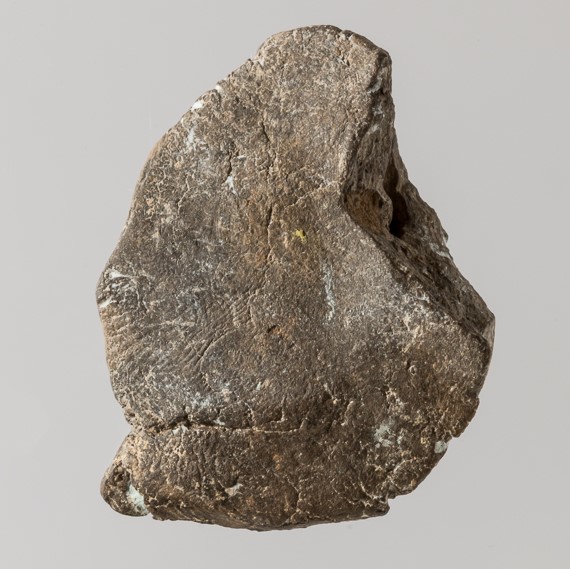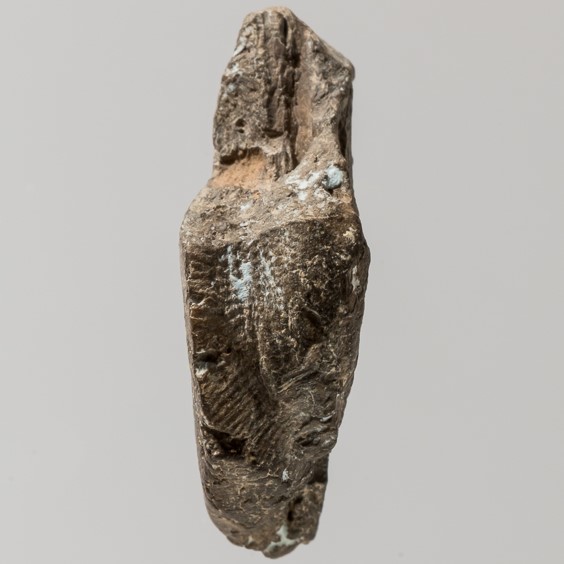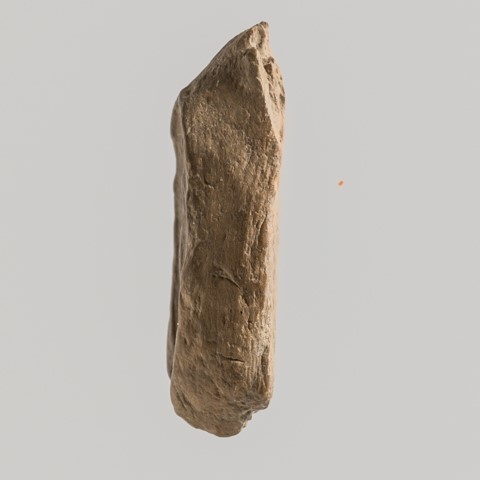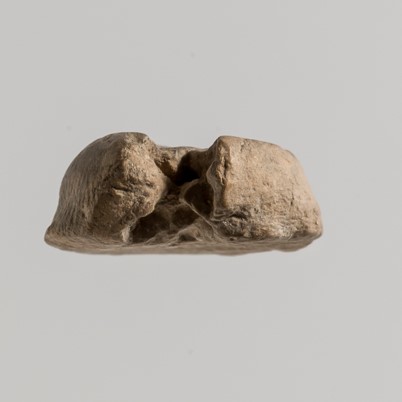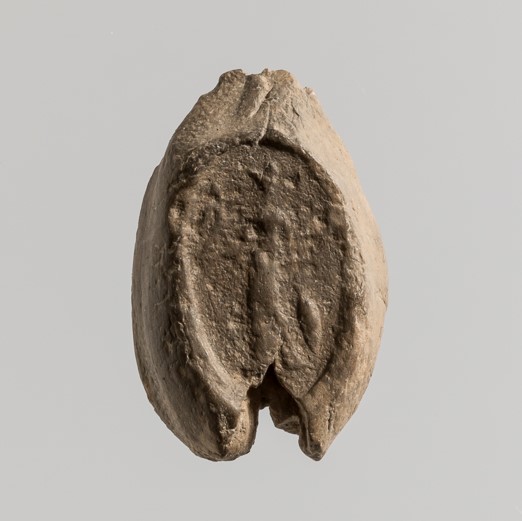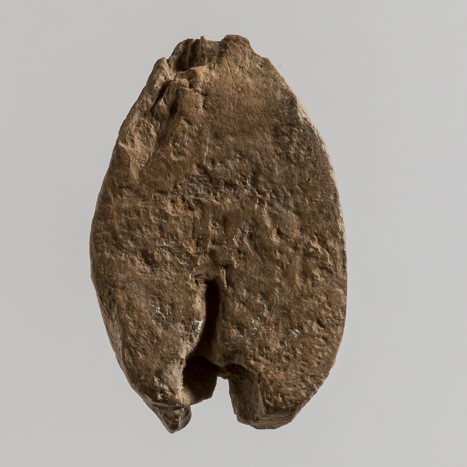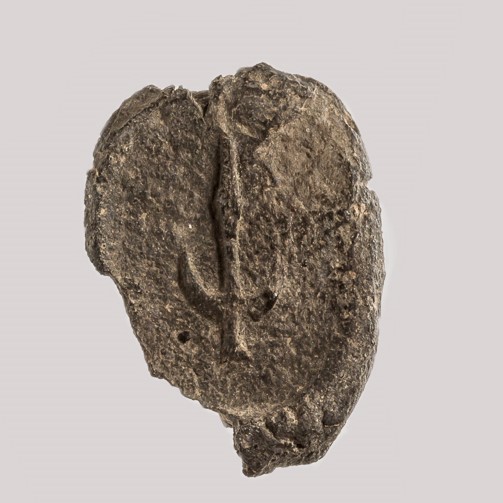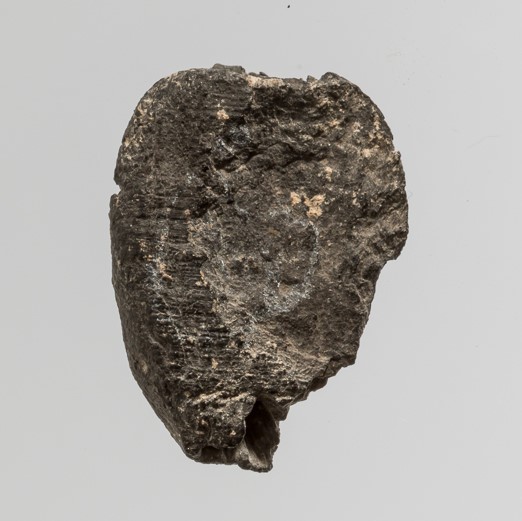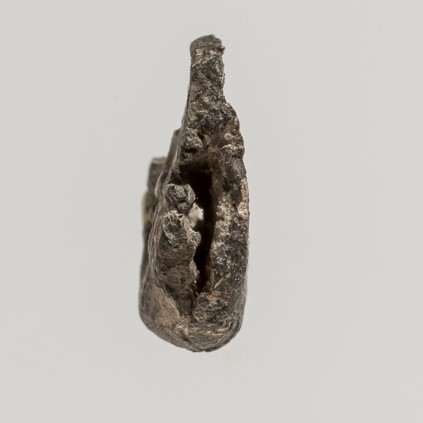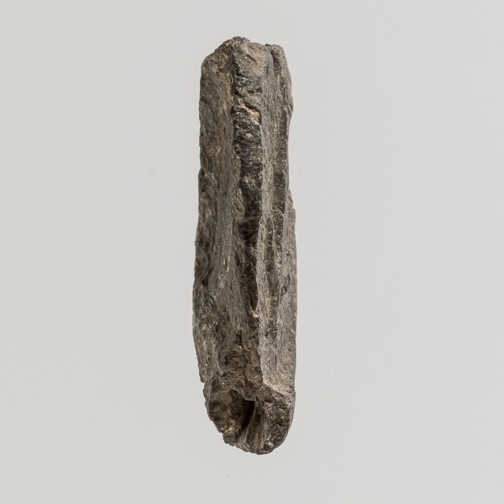Acquisition number: 2013.05
Four Hellenistic seal impressions from Jebel Khalid
1. (JK.S.1) Bitumen(?), pierced with hole for string. Anchor.
2. (JK.S.2) Unbaked clay, small hole for string. Athena draped and helmeted. Shield resting on ground to right. In her right hand holding Nike; in her left a wreath.
3. (JK.S.3) Bitumen, pierced with hole for string. Bearded Zeus seated in high-backed throne. In left hand a sceptre; in his right hand Nike. Tripod and cauldron. Legend ΝΙΚΗΦΟΡΟ[Σ] (Nikephoro[s]).
4. (JK.S.4) Unbaked clay, groove for string. Bust of Athena, wearing crested Corinthian helmet and aegis.
Title: Four Hellenistic seal impressions from Jebel Khalid - 2013.05
Acquisition number: 2013.05
Author or editor: Emma Griggs
Culture or period: Hellenistic.
Date: 3rd - 2nd century BC.
Material: Bitumen
Object type: Other
Origin region or location: Syria
Origin city: Jebel Khalid.
Display case or on loan: 6
Keywords: Hellenistic, Jebel Khalid, Seal Impression, Athena, Nike, Zeus, Nikephoros
C. G. Starr, ‘A Sixth-century Athenian Tetradrachm Used to Seal a Clay Tablet from Persepolis’, The Numismatic Chronicle 16.136, 1976, 219-222
G.W. Clarke, ‘Four Hellenistic seal impressions’, in Jebel Khalid on the Euphrates, vol.1: Report on Excavation 1986-1996, Mediterranean Archaeology Supplement 5. (Sydney, 2002), 201-203
O.D. Hooper, ‘Review: Jebel Khalid on the Euphrates’, The Magazine of the American Numismatic Society 1.2, 2002
R.H. McDowell, Stamped and Inscribed Objects from Seleucia on the Tigris (Ann Arbor, 1935)
2013.05
Four Hellenistic seal impressions from Jebel Khalid
On loan from Professor Graeme Clarke AO FAHA, co-director of excavations at Jebel Khalid, Syria.
These four clay seal impressions were found during the 1996 excavation season at Jebel Khalid. Three of the four seals (JK S.1-3) were found at the Governor's Palace on the Acropolis, an area that was certainly the settlement's bureaucratic centre. Two of the seals were found at the lowest floor level in Room 22, and the third was found adjacent to the doorway into Room 22. The fourth seal, JK S.4, was found outside at the Main Gate North, where there was a large rubbish mound.
It is not possible to definitively date these seals, but they are probably from 3rd or 2nd century BC, the period when the settlement was most active. A dominant Greek presence at Jebel Khalid is unmistakably demonstrated through the iconography of these four official Seleucid seals found on the Acropolis. The iconography of all four seals is based on Seleucid coinage throughout this period.
The primary function of a seal was to identify and authenticate the authority of the person it represents. Clarke argues that their find place in the Governor’s Palace almost certainly indicates that all four seals would have been official seals used in Jebel Khalid's administration. Whereas Hoover agrees that it is likely that JK S.1 was an official seal, he suggests treating Clarke's assertion that JK S. 2-4 were official seals with some caution. Hoover contends that some features on the seals, such as the details of Zeus and the bust of Athena (JK S.3 & 4), differ from the official Seleucid numismatic iconography. As a result, he argues that it is more likely that these seals would have been personal seals modelled after royal Seleucid coinage, a practice that was not uncommon in the Near East. See C. G. Starr, ‘A Sixth-Century Athenian Tetradrachm Used to Seal a Clay Tablet from Persepolis’, The Numismatic Chronicle, 16.136, 1976, 219-222.
96.2438
JK S.1
Found at the Acropolis in Room 22, Trench 61, locus 2 context 2, spit 3.
25x19mm; thickness: 6mm
It is an oval seal, probably made from bitumen.
It is pierced with a hole for a string to be threaded through. The iconography on the seal is an anchor. There are perhaps the faint beginnings of another symbol where the surface is damaged at the head of the anchor. The back is unstamped.
The anchor was a personal symbol of the Seleucids and thus appeared frequently on official coinage. For discussion of the anchor on Seleucid seals, see McDowell 1935, 34 and 161ff. When this emblem appears on seals, it appears to have exclusively represented the Seleucid Royal Treasury and is a symbol for royal power. This seal may have been used to seal bags of currency or official fiscal documents.
95.209
JK S.2
Found at the Acropolis in Trench 50.
25x16mm; thickness 6mm (impressed area: 19x10mm)
Made from unbaked fine light brown clay. There is a small hole for a string attachment, but it is broken at the base by the string hole. The back is unstamped. The symbol on the seal is Athena, draped and helmeted, facing left. There is a shield resting upright on the ground to the right, and a spear is leaning at an angle to the left. Athena's right arm is outstretched, holding Nike, whose left arm is upraised, holding a wreath. There is a trace of a monogram below the left arm, possibly theta and epsilon in ligature. The monogram detail on the seal is not a particularly common feature of Seleucid coinage or seals, although there are some examples.
Athena Nikephoros occurs somewhat frequently on Seleucid coinage. The figure of Athena Nikephoros originates from the Phidian Athena Parthenos, but in its present form on the seal it represents a cult statue in Antioch set up by Alexander Balas.
The seal bears a recognisable Seleucid image, indicating that it was probably used by a royal steward or a bureaucratic administrator. It is a seal of an agent of royalty.
Inv 96.136
JK S.3
33x24; thickness: 10mm (oval impressions 26x20mm)
Found on the Acropolis, Trench 61, locus 1, context 2, spit 3.
Oval seal made from bitumen. Pierced with a hole for string attachment. The seal is damaged at the top left and bottom. There are fingerprints on the rim of the seal. Unstamped on back.
The symbol is of a bearded Zeus, seated on a high-backed throne and holding a long sceptre in his left hand, raised high above his left shoulder. Zeus’ right hand is outstretched holding Nike. A tripod lebes (cauldron) is in front of the throne. Legend to right of the sceptre is ΝΙΚΗΦΟΡΟ[Σ] (Nikephoro[s]).
The figure of Zeus Nikephoros is a common type on Seleucid coins, and it features particularly on the coinage of Antiochus IV with the epithet NΙΚΗΦΟΡΟY. The tripod lebes was also a frequent symbol of the Seleucids and appeared on both coins and seals.
Like JK S.2, the seal bears an official image and would represent the seal of a royal official.
JK S.4 Inv. 91.727
41x34mm; thickness 9mm (impressed area 19mm in diameter)
Main Gate North, Tr. 91/2 (surface find)
This seal, unlike the other three, was found near the Main Gate North.
Circular seal made from unbaked clay that is medium brown in colour. The top right and back are broken off, but the groove for a string attachment is visible. A fingerprint is visible on the left side.
Bust of Athena in right profile wearing a crested Corinthian helmet and aegis. Long curls falling down her neck and long crest trailing down from the helmet at the back. Similar busts of Athena occur on Seleucid coin types.
This seal would probably have been an impression from the seal of a Seleucid functionary.
C. G. Starr, ‘A Sixth-century Athenian Tetradrachm Used to Seal a Clay Tablet from Persepolis’, The Numismatic Chronicle 16.136, 1976, 219-222
G.W. Clarke, ‘Four Hellenistic seal impressions’, in Jebel Khalid on the Euphrates, vol.1: Report on Excavation 1986-1996, Mediterranean Archaeology Supplement 5. (Sydney, 2002), 201-203
O.D. Hooper, ‘Review: Jebel Khalid on the Euphrates’, The Magazine of the American Numismatic Society 1.2, 2002
R.H. McDowell, Stamped and Inscribed Objects from Seleucia on the Tigris (Ann Arbor, 1935)
On loan (Professor Graeme Clarke).
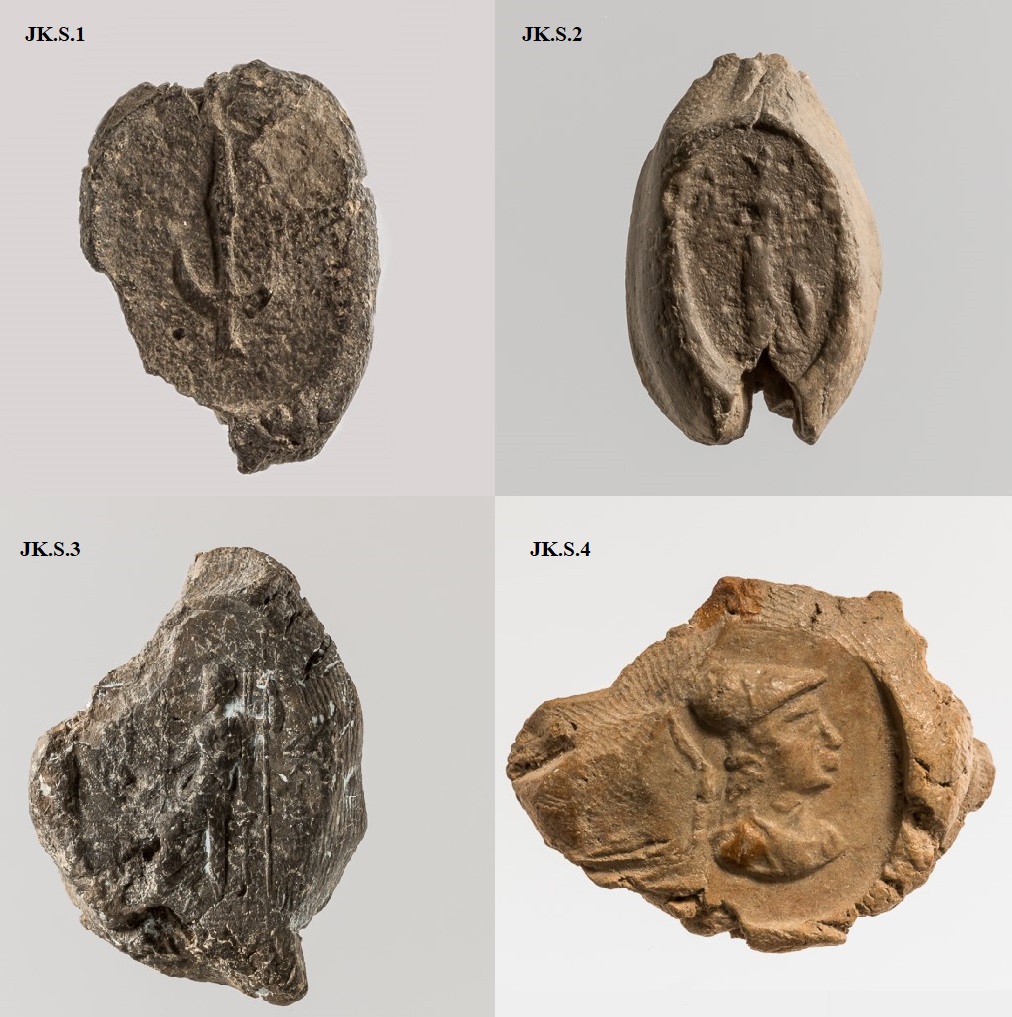
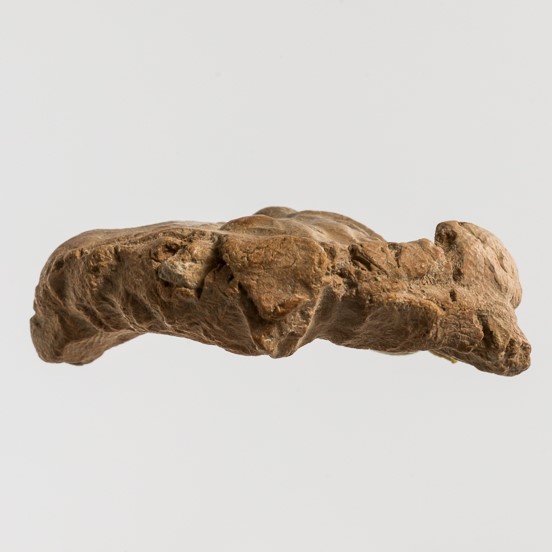
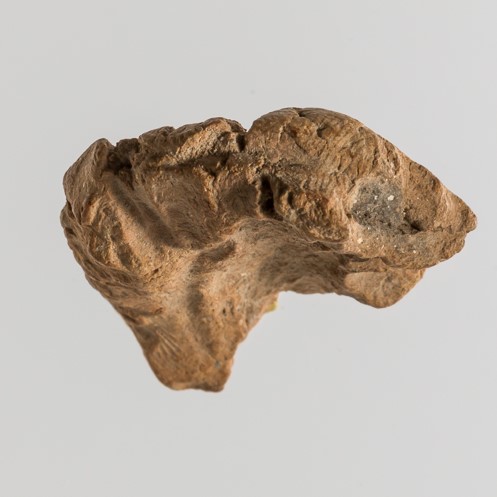
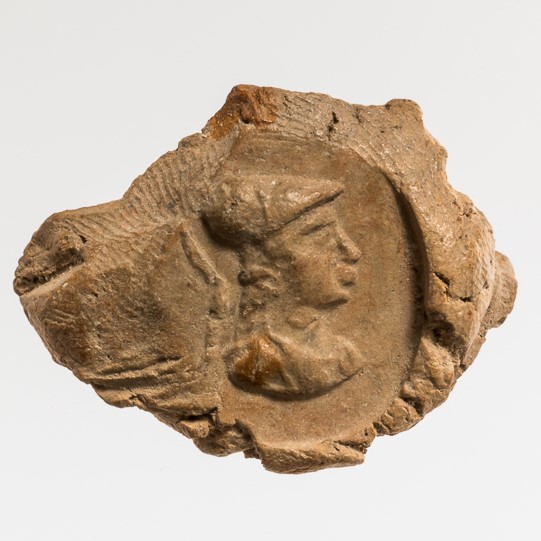
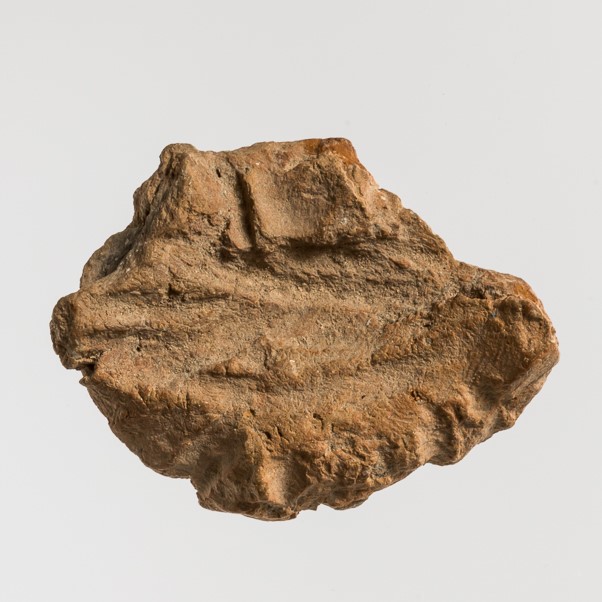
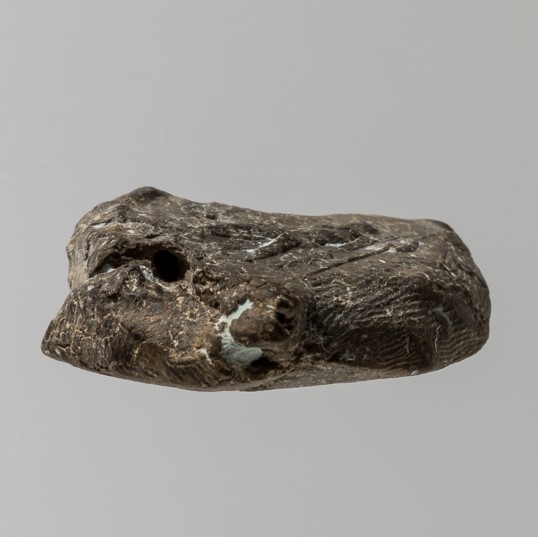
![JK.S.3. Showing Bearded Zeus seated in high-backed throne. In left hand a sceptre; in his right hand Nike. Tripod and cauldron. Legend ΝΙΚΗΦΟΡΟ[Σ] (Nikephoro[s]).](/files/artifacts/gallery/2025/6/2013.05%252520a.jpg)
